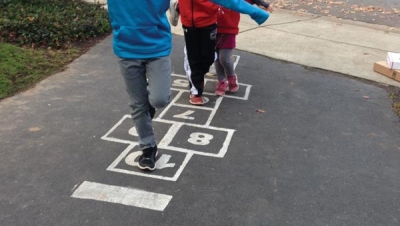family play day at the playground
Admit it, when you read “more” in the title, your first thought was in regard to the number of resolutions, right? On the contrary, when we say “more” we don’t mean make more resolutions, we mean get more people involved. The more people you involve in a resolution, the more likely it is to stick. Accountability is a powerful thing.
According to the University of Scranton’s Journal of clinical psychology, 45% of people usually make New Year’s resolutions, and only 8% of people feel they are successful in carrying them through. According to the same source, the top resolution has to do with losing weight. Also included in the top ten resolutions: enjoying life, being fit and healthy, and spending more time with the family. With such noble goals, why do we have such a difficult time with success?
One major reason is our perception of failure. It’s all or nothing. If we slip and have that cheeseburger or milkshake, we get very discouraged and heap guilt upon ourselves. The next time we slip, it’s generally game over and back to the old habits. It’s important to remember that we don’t form bad habits in a day, month, or even a year; so we shouldn’t expect to change them that fast either. The important thing is to move forward continually. Some days we make great progress in some areas; other days we seem to slide backward a bit. It also helps to make resolutions concrete and specific to help them be more attainable. Instead of “I’m going to eat healthier” say, “I am going to have a salad with a total of less than 500 calories each day for dinner.” Easy to define, to measure, and therefore to stick to!
It stands to reason then, that if involving people in resolutions helps guide success through accountability, and a major goal of many is to spend more time with the family, then our family can be a powerful tool in resolution success! One thing we can all resolve to do is to get more active and ensure that active behavior is important enough to our children that they become lifelong habits. Resolutions also give us a great avenue to teach the importance of goal setting and achievement to our children, and to spark meaningful family conversations.
When setting family resolutions, it’s important to let the family have input on the goals and how they will be achieved, so that everyone has buy in and doesn't feel like they are being “dragged along” in something they aren’t interested in. One way to ensure the family is productive in choosing sensible resolutions is to create an overall goal, for example, “spending more time together in healthy activity.” This way, family members understand that suggestions have to involve the whole family, and that the activities must center on healthy behavior. Then the family can work together as a team to craft the resolutions that will help reach the goal, and get everyone’s buy-in. Instead of saying, “we as your parents have decided,” you send the message, “let’s think collectively about how we can improve our lives and spend more time together in the process.”
Here are some specific ideas to get your family’s creative conversations going:
Family Play Day Go to the local park each Saturday as a family, and spend at least 1 hour engaging in active behavior. This also gives you the opportunity to plan as a family and spend quality time deciding what the activity will be. Maybe time on the playground (this means you too mom and dad, no bench sitting) or a walk around a lake or pond, or even a game of Frisbee. Whatever it is, plan it, do it, check it off each week. To keep the activities varied and fun for everyone, let each family member take a turn at planning the activity for Family Play Day.
Count your Steps Get each member of the family a pedometer (they do not have to be expensive, we found some on Amazon as low as $2!) and have them record their steps each day. Make a game of it, and create a fun reward for the person with the most steps each week, maybe a skipped chore or the right to choose the next family play day activity. The real benefit isn’t the reward; it’s the fact that each family member is being thoughtful about activity, tracking it, and striving to increase it!
Hydrate for Health Instead of sugary sodas or juices, drink water. Water can help control calorie intake, energizes muscles, and helps your body perform better overall. This one is especially easy to achieve at home; if sugary drinks are not in the refrigerator, no one can be tempted to drink them!
Eat Breakfast Together Breakfast is important to fuel the day, and whether you drink a fresh fruit smoothie or sit down with a bowl of oatmeal, make sure that each family member eats something sensible before leaving the house. Eating a good breakfast provides fuel to start the day right, and eliminates the temptation to eat junk. Resolve to keep healthy foods and fruit stocked in the kitchen and readily accessible for the mornings to help the entire family stick to this goal. If scheduling doesn’t allow this during the week, resolve to eat family breakfasts on weekends. Once you have created a regular schedule for family breakfasts, start working on increasing the number of dinners you eat together as a family.
Get Nurtured by Nature Once a week, choose an outdoor discovery adventure for the family. Pack healthy snacks, water, and get outdoors! Getting outside is great exercise, teaches children to appreciate the wonder of our natural world, and can have a relaxing effect on everyone. You can increase family participation by voting on where to go, choosing snacks together, sharing a camera to take photos, and creating a family photo log for each weekly journey when you get home. The log can contain photos, captions, and details on what each family liked (or didn’t like) about the trip. (Or choose a different family member to create the log for each trip, and then ask them to share it with the rest of the family.)
Food for Thought There are a variety of ways to teach kids about healthy food choices. Fooducate is a free app that gives food a grade for how healthy it is. Let kids scan the bar codes as you shop and tell you whether you should buy it or not. Like school grades, an A or B are good, a C is ok, and a D and F are not good. Let children help plan family meals, and tell the family during the meal about the grades that each food earned. If you don’t have a smart phone, you can play the “Natural or Factory” game, to determine food value. Ask children to tell you where the food you are buying comes from. If the answer is a natural source, like “tree, ground, grains, cow, etc., it is “natural” and gets a high score. If the food was made in a “factory,” you need to decide as a family if it is really healthy and good to eat.
Unplug it Day Once a week, designate a day (or evening) where the family unplugs from electronics. By eliminating computers, phones, TV, and video games from the available activities, families are more likely to increase communication among each other. Whether you cook a meal together, play board games, go visit friends or family, or spend time walking and relaxing, unplugging for a day is a great way to encourage family togetherness.
Whatever you decide to do, remember to plan for those times when sticking to the resolution become difficult, so that you don’t lose sight of the overall goal. Scheduling challenges and roadblocks are a fact of life, so when they happen, anticipate them, and then get right back to the goal. Also, remember to celebrate your successes and milestones along the way!
Creating healthy New Year’s resolutions for the entire family, then keeping everyone involved in accountability is a great benefit to everyone. By teaching healthy habits to children while they are young, you also help increase the chance that they don’t have to make the same resolutions when they are adults.
We’d love to hear about your family resolutions! Share them in the comments section below, then check back later and tell us how you did!






